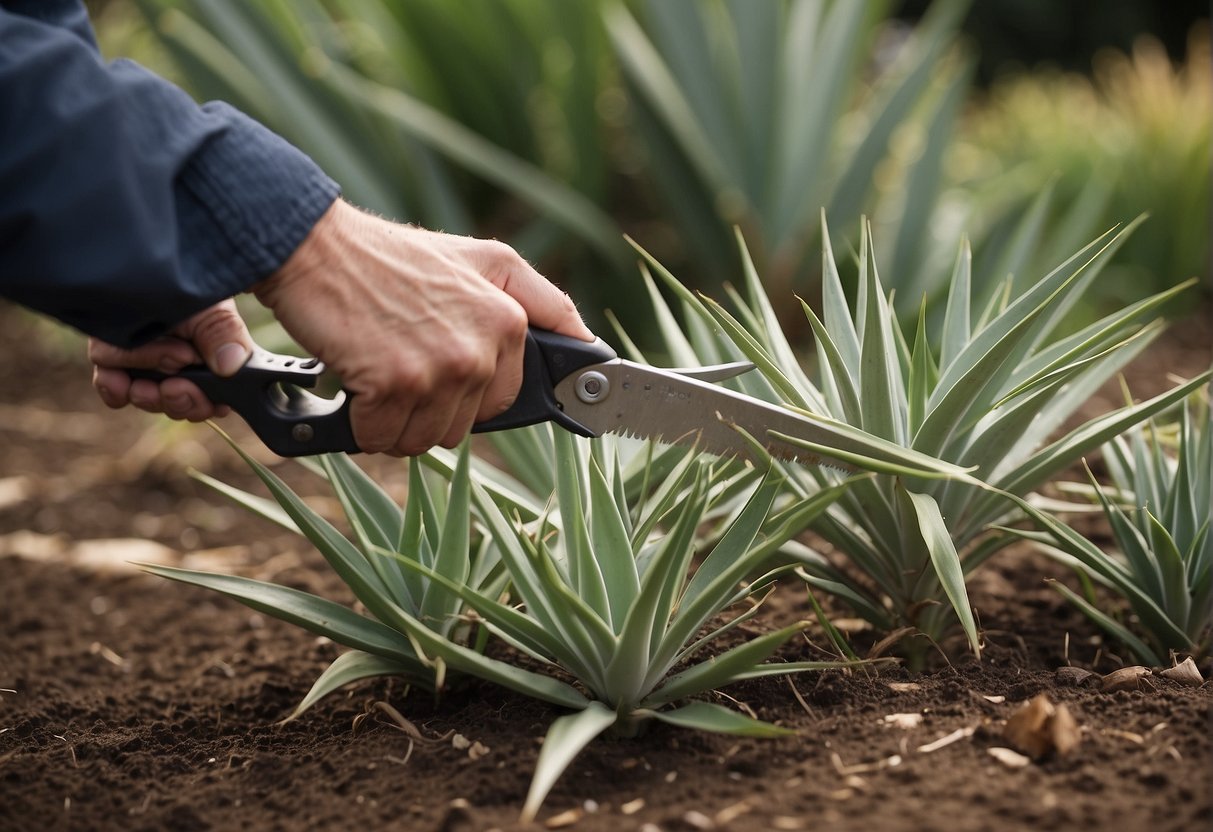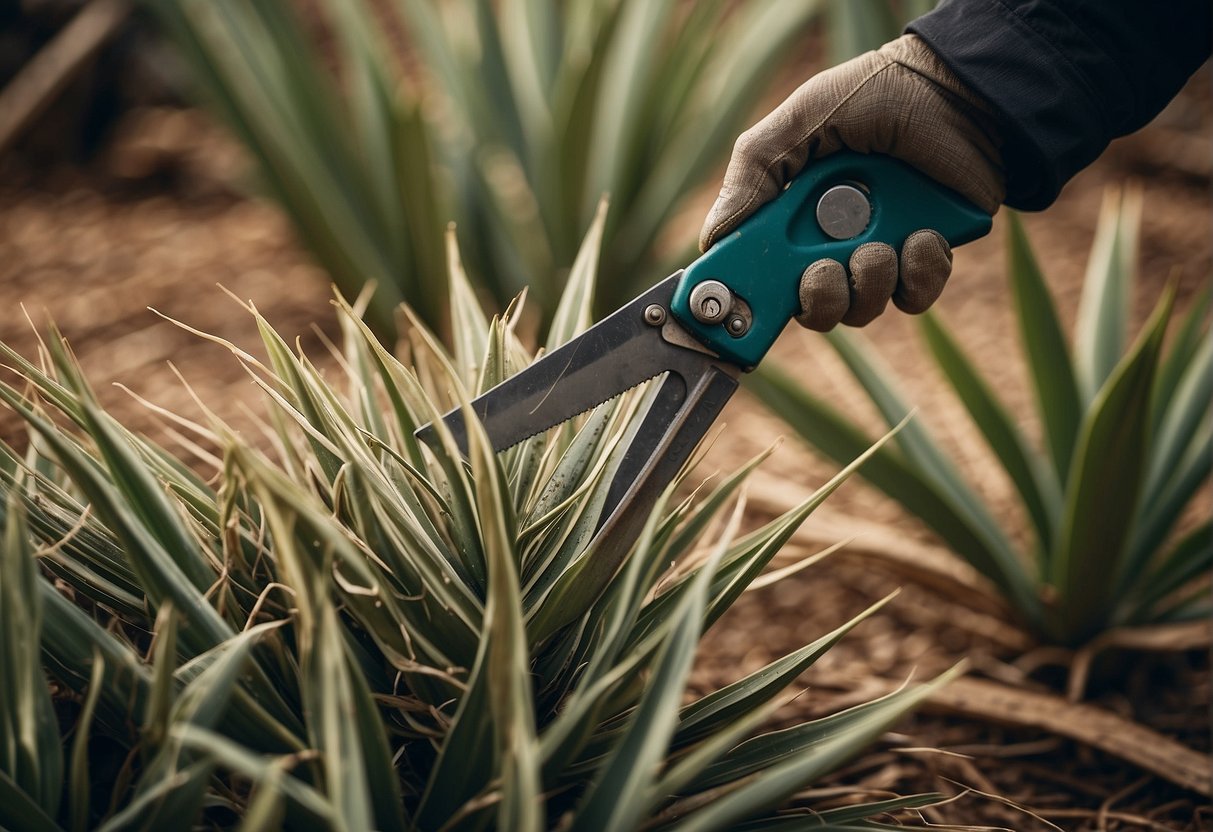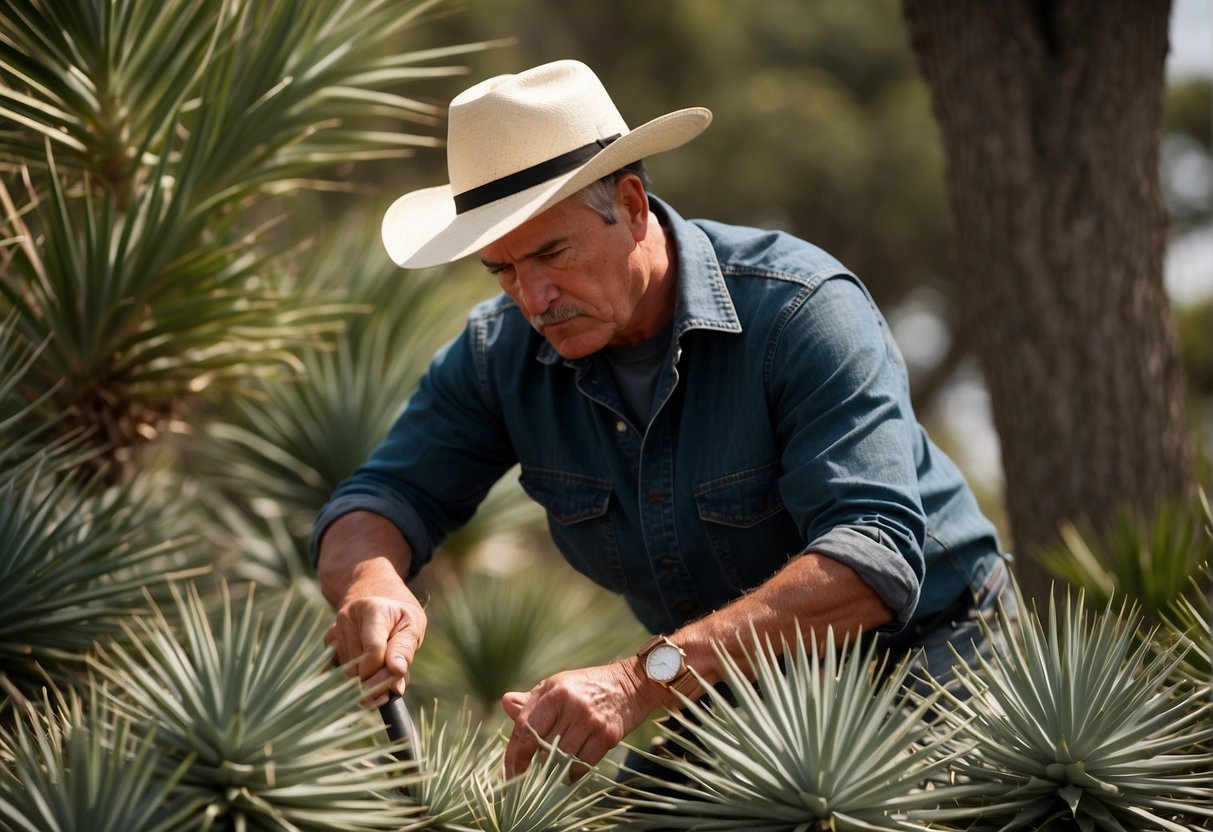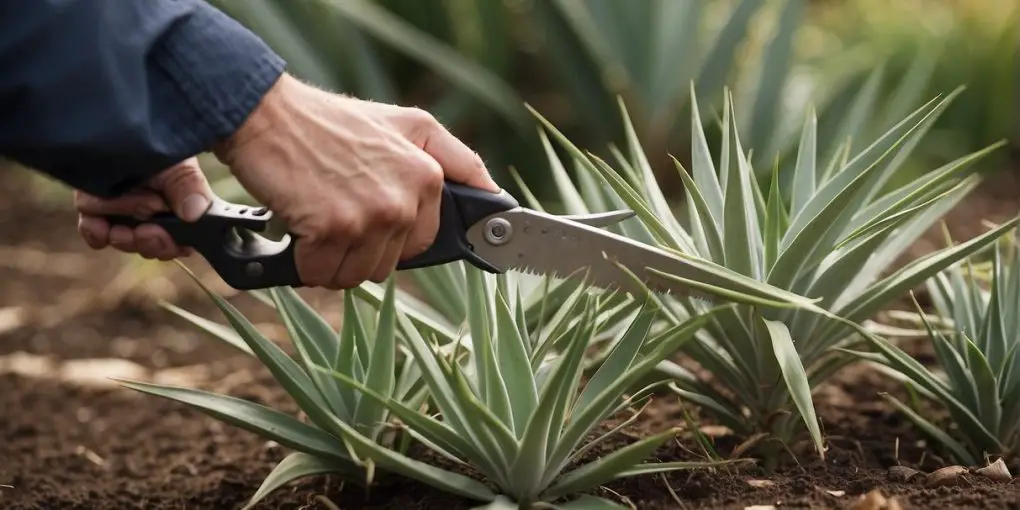How to Trim Yucca Plants: Essential Pruning Tips
Pruning a yucca plant is a crucial step in its upkeep to guarantee it keeps looking splendid and stays in good health. Yuccas are favored for both indoor and outdoor settings because of their minimal care needs and impressive looks. While they’re generally simple to maintain, understanding the optimal moments and methods for trimming can greatly impact their vitality and development.

Appropriate pruning helps maintain the plant’s structure, encourages new growth, and removes dead or damaged foliage. Before you start trimming your yucca, it’s important to prepare the correct tools and understand the plant’s specific needs. This can include knowing how to identify which leaves to trim and how to prevent the potential spread of disease during the process. Following the right steps not only enhances the plant’s aesthetic appeal but also supports its long-term vigor.
Key Takeaways
- Proper pruning maintains structure and health in yucca plants.
- Prepare appropriate tools and understand the plant’s needs before trimming.
- Pruning technique influences the plant’s appearance and growth.
Understanding Yucca Plants
Before you begin trimming your yucca plant, it’s important to understand its characteristics and why pruning can promote a more vibrant, healthy plant.
Characteristics and Growth Patterns
Yucca plants are hardy perennials recognized for their sword-like leaves and towering flower stalks. They thrive in full sun and can adapt to a variety of soil conditions. Growing patterns vary among species, but many yuccas feature a rosette of leaves and can reach up to ten feet tall, if not more, under optimal conditions. Here are a few key aspects of their growth:
- Sunlight Needs: Full sun (at least 6 hours of direct sunlight daily).
- Soil Requirements: Well-draining with a preference for sandy soils.
- Watering Schedule: Low. Allow soil to dry out between watering sessions.
- Average Growth Rate: Slow to moderate; flowering occurs typically during the warmer months.
Benefits of Pruning
Pruning your yucca plant is essential for its health and appearance:
- Encourages Healthy Growth: By removing dead or damaged leaves, you facilitate better air circulation and reduce the risk of disease.
- Promotes Blooming: Occasional trimming keeps the plant looking tidy and can stimulate the growth of its characteristic blooms.
- Maintains Compact Growth: Pruning helps to manage the size and shape of your yucca, ensuring it doesn’t outgrow its space.
By integrating these practices, your yucca plant will not only look its best but will also have the best chance for healthy growth and blooming.
When to Prune Yucca Plants

Pruning your yucca plant ensures it maintains its aesthetic and health. Timing is crucial to avoid interrupting its growth cycle or blooming period.
Optimal Pruning Time
To optimize the health and appearance of your yucca plant, it is best to prune in the late spring. This timing allows the plant to recover and grow vigorously during the active growing season. Early summer can also be suitable for trimming yuccas that haven’t been pruned in spring. It’s essential to complete any pruning before bloom stalks develop to prevent cutting off the season’s flowers.
Pre-Pruning Preparations

Before trimming your yucca plant, it’s crucial to have the right tools on hand and follow safety protocols to ensure a smooth pruning process.
Gathering Necessary Tools
To effectively prune a yucca, you will need:
- Pruning shears: Ideal for cutting through thin stems.
- Sharp knife: Helps with removing small, unwanted sections cleanly.
- Pruning saw: For thicker stems that shears cannot handle.
- Scissors: Can be useful for precision trimming of dead leaves.
Ensure that all tools are clean and sharp to prevent disease transmission and achieve clean cuts.
Safety and Precautions
Your safety is paramount when pruning a yucca plant.
- Safety glasses: Protects your eyes from potential plant sap splashes.
- Protective gear: Gloves are essential to protect your hands from sharp leaves and edges.
Always approach the plant cautiously, aware of the pointed leaves. Keep your work area clear to avoid tripping hazards and ensure a safe pruning experience.
Pruning Techniques for Yucca Plants
Pruning yucca plants is essential to maintain their appearance and health. Proper trimming techniques help manage the plant size, remove dead or damaged leaves, and can also influence airflow and blooming.
Trimming Dead or Damaged Leaves
To keep your yucca plant healthy, regularly inspect it for dead or damaged leaves. Use sharp, sterile shears and cut the leaf off at the base where it emerges from the trunk.
-
Do:
- Inspect for leaves that are brown, wilted, or damaged.
- Sterilize cutting tools before use to prevent disease spread.
-
Don’t:
- Pull leaves off as this can damage the trunk.
- Cut into the healthy tissue of the plant.
Reducing Plant Size
Over time, yucca plants can become too large for their space. To reduce the plant’s size, trim the new shoots to a manageable length.
- How to Reduce Size:
- Cut new shoots back to half their length.
- Trim unwanted shoots at their point of origin.
To retain the aesthetic, make cuts at an angle and mimic the natural shape of the plant.
Managing the Flower Stalk
After blooming, yucca plants develop a flower stalk which should be removed, or deadheaded, to direct energy back to the main plant.
- Steps for Deadheading:
- Locate the base of the flower stalk.
- Use clean shears to cut the stalk as close to the base without damaging nearby shoots.
Flower stalks can be quite tough; ensure your cutting tool is adequate for the job.
Thinning for Airflow
Thinning yucca plants improves airflow, which is crucial to prevent disease. Remove some inner leaves to open the plant’s center.
Thinning Process:
- Selectively cut leaves from the inner regions of the plant.
- Aim for even spacing between leaves for uniform airflow.
Remember to discard all removed plant materials to prevent the spread of pests and diseases.
Propagation and Disease Management
To successfully expand your yucca collection and maintain the health of your plants, understanding propagation methods and disease management is essential. Both require attention to detail and an awareness of the signs of problems to take timely action.
Propagating New Shoots
Yucca plants can be propagated through the separation of new shoots that emerge from the base of the plant. Make sure to:
- Choose a Shoot: Select a healthy and robust new shoot.
- Separate: Gently remove the shoot from the mother plant, ensuring it has some root.
- Potting: Plant the shoot in well-draining soil, watering it to help establish roots.
Timing is crucial for success. It’s best to propagate in spring or early summer.
Identifying and Treating Pests and Disease
Yucca plants can be susceptible to various pests and diseases. Early identification and treatment can prevent an infestation from spreading. Common pests include yucca weevils and scale insects. If you notice:
- Tiny holes in the leaves.
- A sticky substance on the plant (honeydew).
- Visible insects on the underside of the leaves.
You may be dealing with a pest infestation. Treat pests with insecticidal soap or neem oil, applying it directly to the affected areas.
For diseases like root rot or fungal spots, you’ll typically see:
- Discoloration of leaves.
- Soft, mushy roots when inspected.
- Spots on the leaves.
Address fungal issues with a fungicide and ensure proper drainage to combat root rot. Always sanitize your tools before and after use to prevent the spread of disease.
Post-Pruning Care
Proper aftercare is crucial to ensure a healthy recovery and promote new growth in your pruned yucca plants. Overwatering and excessive fertilization can impede the plant’s recovery, so monitoring and adjusting care are key steps.
Watering and Fertilizing
After trimming your yucca, be attentive to watering. Yuccas require a well-draining soil to avoid root rot, which can be exacerbated by overwatering.
Watering Guidelines:
- Frequency: Water lightly immediately after pruning to help reduce stress. Then, allow the soil to dry out completely before watering again.
- Amount: When you do water, ensure the soil is moistened but not waterlogged.
Fertilizing should be done with care as yuccas don’t require heavy feeding.
Fertilizer Application:
- Type: Use a balanced, slow-release fertilizer.
- Timing: Apply fertilizer to your yucca plant in the spring, usually about a month after pruning.
Monitoring Plant Recovery
Observing your yucca’s response after pruning is important for its overall health and to promote new growth.
- New Growth: Look out for new leaves sprouting at the pruning site. This is a sign the yucca is healing well.
- Health Indicators: Be alert to the plant’s foliage. If you notice signs of yellowing or wilting, assess your watering and fertilizing practices.
- Care Adjustments: Be prepared to adjust your aftercare approach based on the plant’s response. If there’s no new growth or if the plant seems stressed, reevaluate your care routine.
Seasonal and Long-Term Maintenance
Yucca plants require regular maintenance to stay healthy and look their best. This maintenance includes a schedule for regular pruning to manage growth and remove dead or damaged leaves.
Regular Pruning Schedule
Spring: Begin your pruning routine as new growth starts. Focus on removing any winter damage.
- March-April: Remove dead leaves from the bottom of the plant.
- May: Prune off flower stalks after blooms fade to redirect energy to the plant.
Summer: Minimal pruning is needed. Inspect your yucca regularly for health.
- June-August: Trim any leaves damaged by summer storms or pests.
Fall: Prepare the yucca for winter by removing any overgrowth.
- September-October: Light pruning for shape and removal of any diseased leaves.
Winter: Pruning is not recommended during this dormant period aside from removing dead material.
- November-February: Inspect and remove only dead or severely damaged leaves to prevent rot.
Frequently Asked Questions
Before attempting to trim your yucca plant, know the appropriate techniques, timing, and the necessary tools for the task. Proper care after pruning will ensure your yucca remains healthy.
What is the proper technique for pruning an overgrown yucca plant?
To prune an overgrown yucca, first identify the main trunk and remove any offshoots or “pups” at the base. Cut back unwanted tall stalks to a manageable height, making clean cuts with sharp pruning shears.
When is the best time of year to trim yucca plants?
The optimal time to trim yucca plants is during the late winter or early spring, just before the growing season begins. This timing helps prevent stress and allows for rapid healing.
How should a yucca plant be cared for after it has been cut back?
After cutting back a yucca, water the plant sparingly and refrain from fertilizing for at least a month to avoid stressing the plant. Ensure it has adequate sunlight.
What are the steps to safely remove dead leaves from a yucca plant?
To remove dead leaves, wear gloves to protect your hands and use a pair of sharp pruning shears. Gently pull the leaf away from the trunk and cut at the base where it meets the stem.
How do you cut a yucca’s flower stalks without harming the plant?
Once the yucca’s flowers have wilted, cut the stalk close to the trunk using clean, sharp tools. Make sure not to damage the surrounding leaves and stems.
Is it necessary to use special tools for trimming a yucca, and if so, what are they?
Using the right tools is essential for trimming a yucca. Sharp pruning shears for smaller stems, a saw for thicker branches, and gloves for protection are necessary. Regularly clean and disinfect your tools to prevent the spread of disease.



